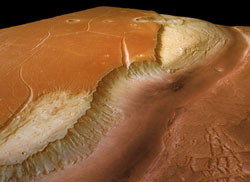Kasei Valles outflow channel system

This image, taken by the High Resolution Stereo Camera (HRSC) on board ESA's Mars Express spacecraft, shows the region of Kasei Valles, one of the biggest outflow channel systems on Mars. The HRSC obtained this image during orbit 1429 on 26 February 2005, at a ground resolution of approximately 29 metres per pixel. The image shows a perspective view of the Northern branch of Kasei Valles looking to the West (the image has been rotated approximately 90 degrees clockwise so that North is to the right). As one of the biggest outflow channel systems on Mars, Kasei Valles was probably formed by gigantic flood events and later additionally shaped by glacial activity. Credits: ESA/DLR/FU Berlin (G. Neukum)
The HRSC obtained these images during orbit 1429 at a ground resolution of approximately 29 metres per pixel.
The Kasei Valles region lies approximately between 21° and 28° North at 292.5° East.
Connecting the southern Echus Chasma and the plain Chryse Planitia in the East, Kasei Valles has a width of roughly 500 kilometres and, if Echus Chasma is included, extends for approximately 2500 kilometres.
There are two sets of images in this release, one showing the North branch, one showing the South branch. Both branches extend approximately South-West to North-East, and the images have been rotated one-quarter clockwise so that North is to the right.
Both valley branches exhibit a depth of 2900 metres.
As one of the biggest outflow channel systems on Mars, Kasei Valles was probably formed by gigantic flood events and later additionally shaped by glacial activity.
In the first set of images, the Northern branch of Kasei Valles and the plain Sacra Mensa can be seen. An oval structure at the western edge of the scene is interpreted to be a crater caused by an oblique meteorite impact.
The Southern branch of Kasei Valles and Sacra Mensa, with its 1- to 2-kilometre-deep graben system, Sacra Fossae, is shown in the second set of images. The terraces are up to 30 kilometres wide, located at the base of the walls on both sides of the valley branch.
The colour scene was derived from three HRSC-colour channels. The perspective views have been calculated from the digital terrain model derived from the stereo channels. The 3D anaglyph images were derived from the stereo and nadir channels. Image resolution has been decreased for use on the internet.
Media Contact
More Information:
http://www.esa.int/SPECIALS/Mars_Express/SEMH916LARE_0.htmlAll latest news from the category: Physics and Astronomy
This area deals with the fundamental laws and building blocks of nature and how they interact, the properties and the behavior of matter, and research into space and time and their structures.
innovations-report provides in-depth reports and articles on subjects such as astrophysics, laser technologies, nuclear, quantum, particle and solid-state physics, nanotechnologies, planetary research and findings (Mars, Venus) and developments related to the Hubble Telescope.
Newest articles

Machine learning algorithm reveals long-theorized glass phase in crystal
Scientists have found evidence of an elusive, glassy phase of matter that emerges when a crystal’s perfect internal pattern is disrupted. X-ray technology and machine learning converge to shed light…

Mapping plant functional diversity from space
HKU ecologists revolutionize ecosystem monitoring with novel field-satellite integration. An international team of researchers, led by Professor Jin WU from the School of Biological Sciences at The University of Hong…

Inverters with constant full load capability
…enable an increase in the performance of electric drives. Overheating components significantly limit the performance of drivetrains in electric vehicles. Inverters in particular are subject to a high thermal load,…





















